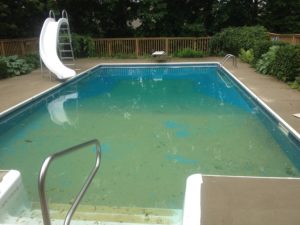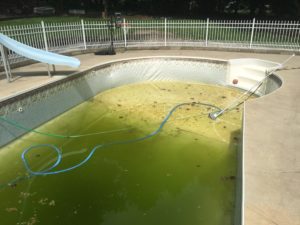 There are different forms and colors of algae. Some forms of algae are aquatic, and some are not. Algae uses the sun to perform photosynthesis to manufacture it’s own food. Algae varies in color and in form – which makes it adaptable to different conditions.
There are different forms and colors of algae. Some forms of algae are aquatic, and some are not. Algae uses the sun to perform photosynthesis to manufacture it’s own food. Algae varies in color and in form – which makes it adaptable to different conditions.
Algae is microscopic in size. By the time you see it in your pool it is an advanced bloom. There are products to help you keep algae from taking over.
1. Keep your sanitizer level at 1-3ppm of Chlorine to prevent algae.
2. Use a weekly algae preventative.
3. If you do have an algae bloom treat, and also treat for phosphates (food for algae). High phosphate levels can lead to algae taking over.
GREEN ALGAE: The most common form of algae
Green Algae varies in color from blue-green to yellow-green and dark green. It can float in the water and turn the wall hazy and green. It can also cling to the wall in patches.
Green algae found on the wall can range from small areas to the entire surface of teh pool being coated. Green algae can clog filters – it can also cause surface damage if left untreated. Treat green algae with shocking the pool to a super chlorinate level (most inground pools 15k-20k gallons will take 4 gallons of liquid chlorine in extreme algae cases, or at the pool opening if the pool is green.)
Some green algae, which is small celled, may cling to the pool surface and the water will remain clear. Treating this as a copper or mineral problem at first glance is common – though it is algae. This type of algae is also resistant to even high levels of chlorine and will “eat up” chlorine quickly. Treat aggressively with shocking, algaecides, and phosphate removers.
In the middle of the summer green algae patches may form in the pool, especially in shady areas such as below the return eyeballs and inside the mouth of the skimmer. The water may remain clear and yet have a “stinging” sensation. This is normal green algae and may result from low levels of sanitizer and the pH and alkalinity running low in the pool.
If any of these are the case, have your water tested and analyzed for the exact water chemistry numbers. Treat with a shock, a good algaecide and brushing/cleaning of the entire pool and pool equipment.
In the case of a Baquacil Pool or pools with alternative sanitizing methods such as Soft Swim or Buguanizes, the Bactericide level should be topped up, and double doses of shock and algaecide should be used.
Yellow Algae
Mustard algae is often mistaken for dirt or sand on the sides of the pool. Mustard algae is resistant to chlorine and is a form of green algae which presents as yellow-green or brown in color. This type of algae is found in areas where there is constant sun on pools during the day, and is not as common in the northern climates where it is often mistakenly identified as the source of the issue.
When determining if you have mustard algae or dirt, if it feels gritty it is dirt or could be calcium scale. If it feels slimy, it’s probably mustard algae.
Mustard algae can be brushed away easily (calcium scale will not brush away), though it will return quickly to the same location. Algae may form in areas in the pool where there are dead spots or dead zones, meaning the water is not circulating in that area. Mustard algae will also climb pool walls. Hint: dirt will not climb walls, and will remain settled on the floor. Though calcium and mineral scale can form on the walls.

Dirt/Sediment Above
Mustard algae will increase the demand for chlorine in the pool, though it may survive even with shocking. It is very important when treating mustard algae to treat and clean all equipment including ladders and inside light niches, as well as any pool equipment, cleaners, or toys and even bathing suits that have been exposed to mustard algae, as it can recontaminate the pool. Pool equipment can be treated by leaving it in the pool during the treatment with chemicals, or cleaned with a mild cleaning solution.

Algae/Sediment Above
To treat yellow algae, have the water tested to determine the exact water chemistry levels. Brush the pool thoroughly before, during and after treatment so the algae slime will be opened and exposed to the chemicals treating it. Aggressively shock with chlorine, and follow your algaecide directions.
